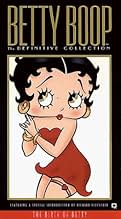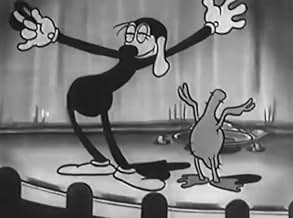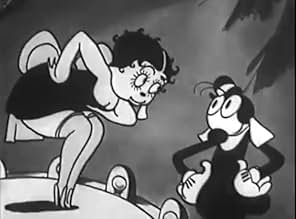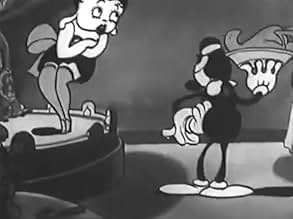Añade un argumento en tu idiomaBetty Boop (with dog's ears) is entertainer in a restaurant for dogs; a waiter joins the floor show to the neglect of patrons.Betty Boop (with dog's ears) is entertainer in a restaurant for dogs; a waiter joins the floor show to the neglect of patrons.Betty Boop (with dog's ears) is entertainer in a restaurant for dogs; a waiter joins the floor show to the neglect of patrons.
William Costello
- Gus Gorilla
- (voz)
- (sin acreditar)
Margie Hines
- Betty Boop
- (voz)
- (sin acreditar)
- …
Billy Murray
- Bimbo
- (voz)
- (sin acreditar)
Walter Scanlan
- Customers
- (sin acreditar)
Reseñas destacadas
Dizzy Dishes (1930)
** 1/2 (out of 4)
This is a somewhat forgettable short but it does have one historically important thing that makes it worth watching. The story is quite simple as everyone in the film is a dog character and we are treated to our main character, a waiter, who is falling behind at work. That's until he walks out into the lobby where we see what would be the first appearance of Betty Boop. DIZZY DISHES isn't all that good as there aren't any laughs and the story itself is nothing special. The reason people will want to watch this is that it does feature the first appearance of Betty Boop, although she doesn't look like she eventually would. She has dog ears here and is a lot taller than what most people think of her as. Fans of Betty will want to check this out even though it doesn't offer much else.
** 1/2 (out of 4)
This is a somewhat forgettable short but it does have one historically important thing that makes it worth watching. The story is quite simple as everyone in the film is a dog character and we are treated to our main character, a waiter, who is falling behind at work. That's until he walks out into the lobby where we see what would be the first appearance of Betty Boop. DIZZY DISHES isn't all that good as there aren't any laughs and the story itself is nothing special. The reason people will want to watch this is that it does feature the first appearance of Betty Boop, although she doesn't look like she eventually would. She has dog ears here and is a lot taller than what most people think of her as. Fans of Betty will want to check this out even though it doesn't offer much else.
Fleischer were responsible for some brilliant cartoons, some of them still among my favourites. Their visual style was often stunning and some of the most imaginative and ahead of its time in animation.
The character of Betty Boop, one of their most famous and prolific characters, may not be for all tastes and sadly not as popular now, but her sex appeal was quite daring for the time and to me there is an adorable sensual charm about her. 'Dizzy Dishes' is a very early cartoon for her, and as well as being nowhere near her best there is the sense that Betty was evolving still, meaning that what made her famous doesn't come through enough and she is not particularly well drawn, pretty weird actually.
Most of the animation is pretty good, the detail and use of black and white is rich and attractive enough and apart from Betty the cartoon is drawn well. The music is infectious and beautifully and cleverly orchestrated, putting one in a good mood and enhances the action wonderfully.
'Dizzy Dishes' does have some cuteness and charm, and the waiter is a lively character. The voice acting is serviceable, but did get better later on.
However, along with Betty underwhelming somewhat, like the post-introduction of production code, if anybody enjoyed the pre-code Betty Boop cartoons for being creative visually, wonderfully surreal and for its daring risqué content that was ahead of the time back in the 30s and wouldn't be seen a lot now in cartoon, they will be disappointed in 'Dizzy Dishes'. Because all of those are missing here, so in comparison to what came later everything feels very safe, tame and dare one say it...bland.
Judging it on its own entity too, the content is thin and only has the odd minor bit of amusement. The story is not just not much of one.
In conclusion, has historical value but there are much better Betty Boop cartoons around. 6/10 Bethany Cox
The character of Betty Boop, one of their most famous and prolific characters, may not be for all tastes and sadly not as popular now, but her sex appeal was quite daring for the time and to me there is an adorable sensual charm about her. 'Dizzy Dishes' is a very early cartoon for her, and as well as being nowhere near her best there is the sense that Betty was evolving still, meaning that what made her famous doesn't come through enough and she is not particularly well drawn, pretty weird actually.
Most of the animation is pretty good, the detail and use of black and white is rich and attractive enough and apart from Betty the cartoon is drawn well. The music is infectious and beautifully and cleverly orchestrated, putting one in a good mood and enhances the action wonderfully.
'Dizzy Dishes' does have some cuteness and charm, and the waiter is a lively character. The voice acting is serviceable, but did get better later on.
However, along with Betty underwhelming somewhat, like the post-introduction of production code, if anybody enjoyed the pre-code Betty Boop cartoons for being creative visually, wonderfully surreal and for its daring risqué content that was ahead of the time back in the 30s and wouldn't be seen a lot now in cartoon, they will be disappointed in 'Dizzy Dishes'. Because all of those are missing here, so in comparison to what came later everything feels very safe, tame and dare one say it...bland.
Judging it on its own entity too, the content is thin and only has the odd minor bit of amusement. The story is not just not much of one.
In conclusion, has historical value but there are much better Betty Boop cartoons around. 6/10 Bethany Cox
Betty Boop to this day remains one of the most cherished cartoon characters of the 20th century, if not of all time. If it weren't for her spunk personality, charming physique and surreal tone, who knows what non-Disney animation would have been like back then. However, when it comes to her first ever appearance, that being the cartoon Dizzy Dishes, it's far from anything great.
Now the cartoon does credit Grim Natwick as the lead animator, and rightfully so as he actually created Betty Boom herself, or at least this can be deemed a prototype. As she was modeled after Helen Kane and Esther Jones, Natwick really knew how to bring this lustrous femme to life through broad animation and bizarre proportions. Even though Max Fleischer took credit, it's always a bonus to give praise to the true man who crafted the og version of Betty that led her to stardom. Also, as this cartoon was made in the early 1930s, it is very fun to see the days where almost every cartoon embraced the surrealistic attributes of visual comedy.
Sadly, that's where my positives end. Although most of the negatives I have for this cartoon are more based off the severe limitations of silent filmmaking back then, they still need to be addressed. For one thing, the sound quality is so bad that it's near impossible to comprehend what the others are saying (even Betty's own song for goodness sake). Plus, the animation is inconsistent and jerky, the jokes don't really hit that well, and even the bouncy feel of cartoon animation back then isn't as thrilling as it sounds here.
And then there's the actual storyline itself. The main character, who would later become Betty's sidekick Bimbo, is a waiter who needs to prepare a roast duck for a hungry customer. However, he gets caught up in the dancing fun to the point where the customer gets aggressively uptight at him. Maybe I'm thinking too much about this, but that customer has every right to be angry at that dog. How much free time can one dog have before it bites him in the butt? Regardless, while I do admire this cartoon for being Betty's first unofficial appearance, I can't get into it because of how little it entertains me.
Now the cartoon does credit Grim Natwick as the lead animator, and rightfully so as he actually created Betty Boom herself, or at least this can be deemed a prototype. As she was modeled after Helen Kane and Esther Jones, Natwick really knew how to bring this lustrous femme to life through broad animation and bizarre proportions. Even though Max Fleischer took credit, it's always a bonus to give praise to the true man who crafted the og version of Betty that led her to stardom. Also, as this cartoon was made in the early 1930s, it is very fun to see the days where almost every cartoon embraced the surrealistic attributes of visual comedy.
Sadly, that's where my positives end. Although most of the negatives I have for this cartoon are more based off the severe limitations of silent filmmaking back then, they still need to be addressed. For one thing, the sound quality is so bad that it's near impossible to comprehend what the others are saying (even Betty's own song for goodness sake). Plus, the animation is inconsistent and jerky, the jokes don't really hit that well, and even the bouncy feel of cartoon animation back then isn't as thrilling as it sounds here.
And then there's the actual storyline itself. The main character, who would later become Betty's sidekick Bimbo, is a waiter who needs to prepare a roast duck for a hungry customer. However, he gets caught up in the dancing fun to the point where the customer gets aggressively uptight at him. Maybe I'm thinking too much about this, but that customer has every right to be angry at that dog. How much free time can one dog have before it bites him in the butt? Regardless, while I do admire this cartoon for being Betty's first unofficial appearance, I can't get into it because of how little it entertains me.
Besides Walt Disney, the Fleischer brothers, Max and Dave, were one of the main producers of animated cartoons in the early 1930s. Much of their success could be attributed to a flapper gal who began her career as a cross between a dog and a female singer. Her name: Betty Boop.
Betty's debut was in August 1930's "Dizzy Dishes" where she's singing a brief song that includes her soon-to-be famous catchphrase 'Boop-Oop-a-doop.' Her birth in film was just an afterthought. "Dizzy Dishes" main character was Bimbo the Pup. Betty doesn't appear until around the six minute mark, while Bimbo, whose name was derived from the term at that time to mean men who like to fight, was seen right from the beginning. "Dizzy Dishes" was part of a 42-cartoon series, labeled 'Talkartoons' that augmented Fleischer Studio's earlier "Screen Songs" series. Those musical animations morphed from the even earlier 'Ko-Ko the Clown" cartoons, who emerged from the 1918 'Out of the Inkwell" series. Ko-Ko later was featured in the follow-the-bouncing-ball films with songs featuring the clown, one of cartoon's first short films with a sound track. Bimbo the Pup was born in that string of cartoons because the Fleischers felt their clown needed a pet.
The Fleischers turned to Bimbo to headline their new Talkartoons. The dog's first lead role was in March 1930's 'Hot Dog.' In Bimbo's seventh featured cartoon, "Dizzy Dishes," Bimbo plays a stressed waiter who can't please anyone in a busy restaurant. While he's serving a table with food, he spots cabaret singer Betty on the stage. She appears as a human, but with a button dog nose, long puppy ears and Cocker Spaniel-like eyes. Betty was drawn to appeal to Bimbo. It was over a year, in January 1932's "Any Rags," before Betty dropped the dog ears, turning them into human with large earrings while she became more feminized.
Max told his animators to pattern the flapper dog Betty after actress singer Helen Kane. The likeness to the movie star was so obvious that Kane sued the Fleischers in 1932 in a $250,000 infringement lawsuit. The actress' case was based on her singing style and her "Boop-Oop-a-doop" signature phrase. The Fleischers refuted Kane's claims by pointing to Harlem singer Esther Jones, a.k.a. Baby Esther, who originated Betty Boop's trademark stanza. Turns out Kane had adopted Jones' singing style and claimed it was her own. The judge agreed with the cartoon studio's contention that Betty Boop was a combination of several singing artists.
Betty's debut was in August 1930's "Dizzy Dishes" where she's singing a brief song that includes her soon-to-be famous catchphrase 'Boop-Oop-a-doop.' Her birth in film was just an afterthought. "Dizzy Dishes" main character was Bimbo the Pup. Betty doesn't appear until around the six minute mark, while Bimbo, whose name was derived from the term at that time to mean men who like to fight, was seen right from the beginning. "Dizzy Dishes" was part of a 42-cartoon series, labeled 'Talkartoons' that augmented Fleischer Studio's earlier "Screen Songs" series. Those musical animations morphed from the even earlier 'Ko-Ko the Clown" cartoons, who emerged from the 1918 'Out of the Inkwell" series. Ko-Ko later was featured in the follow-the-bouncing-ball films with songs featuring the clown, one of cartoon's first short films with a sound track. Bimbo the Pup was born in that string of cartoons because the Fleischers felt their clown needed a pet.
The Fleischers turned to Bimbo to headline their new Talkartoons. The dog's first lead role was in March 1930's 'Hot Dog.' In Bimbo's seventh featured cartoon, "Dizzy Dishes," Bimbo plays a stressed waiter who can't please anyone in a busy restaurant. While he's serving a table with food, he spots cabaret singer Betty on the stage. She appears as a human, but with a button dog nose, long puppy ears and Cocker Spaniel-like eyes. Betty was drawn to appeal to Bimbo. It was over a year, in January 1932's "Any Rags," before Betty dropped the dog ears, turning them into human with large earrings while she became more feminized.
Max told his animators to pattern the flapper dog Betty after actress singer Helen Kane. The likeness to the movie star was so obvious that Kane sued the Fleischers in 1932 in a $250,000 infringement lawsuit. The actress' case was based on her singing style and her "Boop-Oop-a-doop" signature phrase. The Fleischers refuted Kane's claims by pointing to Harlem singer Esther Jones, a.k.a. Baby Esther, who originated Betty Boop's trademark stanza. Turns out Kane had adopted Jones' singing style and claimed it was her own. The judge agreed with the cartoon studio's contention that Betty Boop was a combination of several singing artists.
I won't dwell on the obvious first appearance of Miss Boop. She really is a dog. This is about one of those restaurants with a bunch of waiters and no cooks. There is one character who dominates the screen and he is totally incompetent. As watcher of cartoons we shouldn't ask questions like, How can this night club even exist?"
¿Sabías que...?
- CuriosidadesBetty Boop was modeled on Paramount starlet Helen Kane.
- Citas
Gus Gorilla: [Gus Gorilla] Where's MY roast duck?
- ConexionesEdited into Betty Boop Confidential (1998)
- Banda sonoraAbaloney
(uncredited)
Traditional
Sung during the opening credits
Selecciones populares
Inicia sesión para calificar y añadir a tu lista para recibir recomendaciones personalizadas
- Why does Betty Boop have dog ears?
Detalles
- Duración6 minutos
- Color
- Mezcla de sonido
- Relación de aspecto
- 1.37 : 1
Contribuir a esta página
Sugerir un cambio o añadir el contenido que falta

Principal laguna de datos
By what name was Dizzy Dishes (1930) officially released in Canada in English?
Responde















